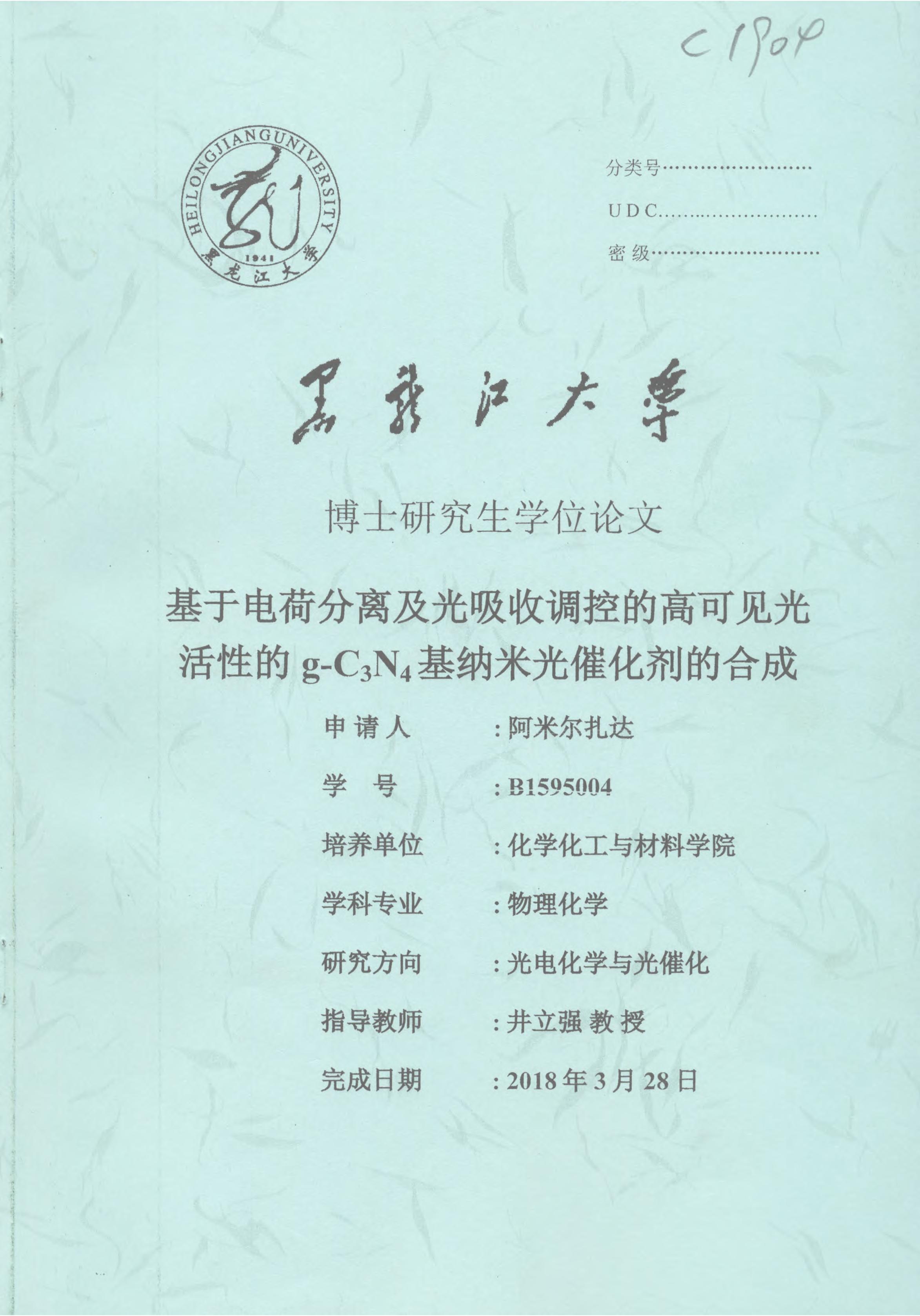| 中文摘要 |
随着工业化的快速发展,环境污染物随意排放,日益严重的环境污染正成为21世纪世界社会面临的另一个极其严重的问题。诸多带有巨大毒性的有毒有害有机污染物被排放进去环境中鸿,严重影响着陆地和水生生物。特别是苯酚及其氯代衍生物是最危险的有机污染物。这些化合物在许多工业生产过程中被广泛使用,对水生动物和人类都造成了严重的问题。由于它们的毒性、稳定性和部分或非生物降解性,使得这些化合物很难从环境中去除,目前需要高效、低成本和环境友好的技术去处理他们,这也是世界上最严重的环境问题之一。光催化利用太阳能照射半导体产生活性氧物种,可高效降解水中的有机污染物,是高级氧化技术。通过发展高效的光催化剂材料,提高光催化性能,实现快速、高效地降解水中氯代酚类等有机污染物是人们共同关心和广泛关注的主要科学问题之一。 另一方面,世界范围内不断增长的能源危机已经导致了许多社会和政治问题。石油、煤炭和天然气等化石燃料的过度使用,导致其自然资源的明显减少。化石燃料的燃烧提供了世界上大约80%的能源,他们的快速消耗和公民社会的现代化引起了严重的关注,并迫使世界各国寻找可再生能源。在植物和一些光合细菌中,通过自然的光合作用,取之不尽的太阳能被转化为化学能。地球上有大量的水,世界各地的科学家都在关注将太阳能储存在氢的化学键中,以满足社会社会日常的能源需求。因此,世界各地的科学家正试图复制所谓的“人工光合作用”的自然光合过程,以满足未来的能源需求。尤其是利用半导体和太阳能的光催化技术将水分解为氢气和氧气是全世界共同瞩目的焦点核心问题。 为了最大限度地减少这些问题的影响,人们正在进行着大量的研究工作,尤其是在材料科学和工程方面,目前已经取得了一些新发现。在各种可再生能源项目中,半导体光催化技术在过去的几年中得到了巨大的应用。作为一项有前途的绿色技术,半导体光催化由于其条件温和、效率高、运行成本低,受到了广泛的关注。在太阳照射下,利用太阳能光子作为唯一的能源供应来源,光催化剂将水直接将有害的有机污染物分解为水和二氧化碳或转化为H₂和O₂,而不会对环境造成任何影响。目前,人们对光催化剂的研究较为广泛,且由于太阳光谱中可见光占有高达46%的比例,因此开发具有可见光响应的窄带隙光催化剂以实现有效的太阳能利用是十分必要的。 石墨化氮化碳(g-C₃N₄)是一种新型的无金属有机半导体,是理想的光催化剂材料。它具有2.7 eV的窄带隙,适当的价带和导带位置,并且有可以从低成本的富氮前体材料中制备的简单方法,已经吸引了大量关注,被用于太阳能分解水产H₂、还原二氧化碳形成能源丰富的化合物和污染物的降解等热点环境能源领域。然而,它的光生电荷的复合率高、可见光吸收范围有限和表面催化弱等关键科学问题限制了其在光催化转化过程中的应用。因此,为了获得高活性的氮化碳光催化剂,采用有效的改性策略如复合宽带隙氧化物作为适当能量电子接收平台维持氮化碳可见光生电子热力学能量,表面修饰等离子共振金属或金属酞菁等作为光敏吸收体拓展可见光吸收,从而提高氮化碳的光催化活性是有意义的。为此,本文针对氮化碳电荷分离、可见光吸收和表面催化等方面存在的关键科学问题提出了以下研究内容: 1.针对g-C₃N₄在可见光催化降解2,4-二氯苯酚、双酚A等有毒有机物过程中,可见光生电子寿命短、光生电荷分离差、可见光响应有限等关键科学问题,提出通过表面耦合宽带隙TiO₂作为适当能级电子接收平台,延长可见光生高水平能级电子寿命、促进电荷分离,并在此基础上进一步修饰具有等离子共振效应的纳米金颗粒,拓展可见光响应,制备等离子Au-(TiO₂/g-C₃N₄)纳米复合体光催化剂材料。首先,我们采用热聚合方法制备CN催化剂材料,继而采用湿化学发将通过简单的水热法制备了TiO₂纳米复合体材料修饰在CN表面,构建TiO₂/g-C₃N₄纳米复合体。所制备的TiO₂/g-C₃N₄纳米复合材料表现出增强的光催化降解活性,这可归因于可见光激发的电子从CN向TiO₂发生转移。此外,为了进一步拓展TiO₂/g-C₃N₄纳米复合材料的可见光吸收,我们采用表面光沉积的方法将金纳米颗粒负载在复合体表面,并研究了其2,4-二氯苯酚(2,4-DCP)和双酚A(BPA)性能。最佳量的2Au-6T/CN纳米复合体在1h可见光照射下对双酚A(BPA)和2,4-二氯苯酚水溶液的降解率分别为37%和46%,比纯CN分别提高了5.11和3.1倍。有趣的是,通过单波长照射2,4-二氯苯酚光催化降解实验证明,制得的2Au-6T/CN光催化剂的可见光响应波长范围扩展到了590nm。经过表面光电压能谱、光电化学I-V曲线和瞬态表面光电压谱(TS-SPV)测试证明,活性的增加主要是归因于激发电子从Au等离子体(590 nm>λ>470 nm)和CN(470 nm>λ>400 nm)转移到TiO₂上带来的更好的表面催化能力,更宽的可见光响应范围和更佳的电荷分离。在有异丙醇作为羟基自由基(·OH)捕获剂的条件下降解2,4-DCP 的测试证明,较大程度上改善的电荷分离产生了大量·OH参与光催化氧化过程。此外,2Au-6T/CN降解BPA和2,4-DCP的速率常数分别是P-25在紫外光照射下降解的速率常数的1.40和1.53倍,进一步确认了通过表面Au纳米颗粒和TiO₂纳米粒子修饰后,g-C₃N₄的光催化性能明显提高。最后,我们通过液相色谱质谱联机等对降解反应中间体进行解析,提出了一个2,4-DCP可能的降解反应机理。这种纳米金复合材料与金纳米粒子光敏化的策略可能对高效可见光催化剂的未来发展具有重要的影响,并为获得可见光用于环境可持续性提供了一个潜在的平台。 2.针对g-C₃N₄在可见光催化产氢过程中,光生电荷分离差、可见光响应有限、表面催化还原能力差等关键科学问题,提出通过表面耦合宽带隙SnO₂作为适当能级电子接收平台,延长可见光生高水平能级电子寿命、促进电荷分离,并在此基础上进一步修饰具有等离子共振效应的纳米金颗粒,拓展可见光响应并同时赋予表面催化还原功能,制备等离子Au/SnO₂/g-C₃N₄纳米复合体光催化剂。首先,我们用双氰胺作为前驱体材料合成了g-C₃N₄(CN)纳米材料,并复合了不同质量百分比的SnO₂(SO)纳米颗粒作为合适的能量平台组成不同的纳米复合材料。继而,通过光沉积将金纳米粒子生长在纳米复合材料表面,形成等离子Au/SnO₂/g-C₃N₄光催化剂,并研究其可见光下催化产H₂性能。在可见光照射并不添加任何额外助催化剂的条件下,所有的光催化剂表现出优越的光催化活性和良好的稳定性。具有最佳性能的2Au/6SO/CN样品在λ>400 nm光照射下产生了大约770 μmol g⁻¹h⁻¹的氢气,而在相同条件下SO/CN(130 μmol g⁻¹),Au/CN(112μmol g⁻¹h⁻¹)和CN(11μmol g⁻¹h⁻¹)。此外,2Au/6SO/CN的催化活性在经历6次,每次30 h的光催化循环实验,其光催化活性基本持续不变。此外,通过表面光电压谱、光电化学I-V曲线、电化学阻抗谱、羟基自由基测试和不同激发波长的光电流作用谱证实了光催化产H₂活性的提高归因于Au(≈520 nm)和CN(470 nm>λ>400 nm)的光生电子转移到SnO₂,从而有效促进了可见光生电荷分离。此外,开尔文探针的测试表明,SnO₂负载形成2Au/6SO/CN时,CN的导带发生轻微的上移约0.13eV,从而形成新的适和光催化还原产氢的热力学能量平台。这项工作提供了一个可行的策略用于合成等离子体辅助的CN基纳米光催化剂,实现有效的太阳能燃料生产,以满足未来全球能源需求。 3.针对g-C₃N₄在可见光催化降解高毒性、高稳定性的2,4,6-三氯酚(2,4,6-TCP)过程中,可见光响应有限的关键科学问题,提出通过表面敏化修饰酞菁钴作为可见光吸收体,拓展g-C₃N₄的可见光吸收,并考虑通过嫁接分子桥的方式加速酞菁钴和g-C₃N₄的电荷转移。我们首先通过三聚氰胺-三聚氰酸热聚合的方法合成了多孔的CN纳米片,在此基础上采用湿化学法负载了酞菁钴染料作为光吸收剂。在可见光照射和不同波长下,通过降解2,4,6-TCP,对合成光催化剂的光催化活性进行了评估。最佳量的0.5 C-CN样品,在可见光下光照1h降解活性为27%。有趣的是,当酞菁钴负载在NaH₂PO₄修饰的CN上时,其光催化活性显著提高到42%。其活性的提高归因于CN和酞菁钴之间的紧密结合,因为酞菁钴扩展了光吸收,以及通过经过修饰的磷酸基团将酞菁钴上的电子转移到CN上促进了电荷分离,这些被表面光电压谱、光致发光光谱、和羟基自由基测试所证实。从捕获实验中,证实了2,4,6-TCP的光催化降解过程中都涉及到空穴和超氧自由基。最后,基于在光催化降解过程中形成的中间产物的鉴定,我们提出了一种可能的降解机制。该研究工作将深入了解光物理和光化学过程,并以明确的机理提供出可行路线用于改善可见光响应的半导体光催化剂的活性来应应用于太阳能源产生和污染物降解。 关键词:g-C₃N₄纳米光催化剂;电荷分离;可见光拓展;金等离子体修饰;酞菁钴敏化;可见光催化。
|
| 英文摘要 |
The growing energy crises and the unrestricted release of objectionable pollutants to the environment have caused comprehensive concerns in scientific society. Photocatalysis presents its environmental friendly service in this area. As a promising green technology, photocatalysis has received enormous attention owing to its mild nature, high efficiency and low cost operational techniques. Under solar irradiation, photocatalysts can make H₂O directly convert into H₂ and O₂, reduce CO₂ into solar fuels and degrade pollutants into H₂O and CO₂ without imposing any threat to the environment. Since the solar spectrum contains nearly 46% of visible light, , it is highly desired to develop narrow band gap photocatalysts for effective solar energy utilization. Polymeric graphitic carbon nitride, g-C₃N₄ (CN) has been extensively utilized for water splitting, CO₂ reduction and pollutants degradation. However, high recombination rate of photogenerated charges, marginal visible-light absorption and weak surface catalysis still limit its practical applications in the photocatalytic conversion processes. Therefore, it is much meaningful to further improve its photocatalytic activities to obtain an efficient photocatalyst. Herein, we have carried out a series of modification strategies to improve charge separation, extend the optical absorption to visible light and improve surface catalysis of CN for enhanced photocatalytic activities to obtain energy rich compounds and safe environment for future generations. The main contents are as follow: 1.Synthesis of plasmonic Au-(TiO₂/-C₃N₄) nanocomposites as efficient visible-light photocatalysts to degrade bisphenol A (BPA) and 2,4-dichlorophenol (2,4-DCP) in aqueous solution under ambient conditions. Plasmonic Au-TiO₂/g-C₃N₄ (Au-T/CN) nanophotocatalysts were fabricated by coupling TiO₂ with CN by wet chemical method and then loading Au nanoparticles by photodeposition method. The photocatalytic activities were studied for the degradation of BPA and 2,4-DCP. The amount optimized 2Au-6T/CN nanocomposite showed degradation activities of 37 and 46% for BPA and 2,4-DCP respectively in 1 h under visible-light irradiation with 5.11 and 3.1 times improvement compared to that of pure CN. Interestingly, the photocatalyst extended the visible-light response of 2Au-6T/CN to 590 nm as proven by the degradation activity of 2 and 4% for BPA and 2,4-DCP respectively at the given wavelength. These enhanced degradation activities are mainly attributed to highly promoted photogenerated charge separation via the excited electron transfer from plasmonic Au (590 nm > λ> 470 nm) and CN (470 nm > λ > 400 nm) to TiO₂ and extended visible-light absorption as indicated by the surface photovoltage spectra, photoelectrochemical l-V curves and transient-state surface photovoltage (TS-SPV) measurement. The highly promoted charge separation resulted in the availability of a large number of hydroxyl radicals (·OH) participating in the photocatalytic oxidation process as confirmed from the degradation of 2,4-DCP in the presence of iso-propyl alcohol as ·OH scavenger. Moreover, the degradation rate constants of BPA and 2,4-DCP with 2Au-6T/CN were 1.40 and 1.53 times higher than their respective degradation rate constants with P-25 under UV-vis light irradiation showing the excellency of the fabricated photocatalyst. Finally, a possible reaction mechanism for the degradation of 2,4-DCP was proposed according to the analysis of the degradation intermediates. 2.Synthesis of surface plasmon assisted Au/SnO₂/g-C₃N₄ nanophotocatalysts for hydrogen evolution. Firstly, g-C₃N₄ (CN) nanosheets have been synthesized using dicyandiamide as precursor material and then coupled with different mass percent ratios of SnO₂ (SO) nanoprtcles.Au nanoparticles were photodeposited on the surfacc of the nanocomposites to form plasmonic Au/SnO₂/g-C₃N₄ photocatalysts and applied in the production of H₂ from water splitting. All the photocatalysts exhibited superior photocatalytic activities and favorable stabilities without any co-catalyst under visiblelight irradiation. The 2Au/6SO/CN nanocomposite produced approximately 770 μmol g⁻¹.h⁻¹ H₂ gas under λ > 400 nm light illumination compared to the H₂ gas output of SO/CN (130 μmol g- 1), Au/CN (112 μmol g⁻¹h⁻¹) and CN (11 μmol g⁻¹ h⁻¹) under the same irradiation conditions. In addition, the photocatalytic activity of 2Au/6SO/CN continued unchanged for 6 runs in 30 h. It is confirmed by means of surface photovoltage spectra, photoelectrochemical l-V curves, electrochemical impedance spectra, examination of formed hydroxyl radicals and photocurrent action spectra as a function of different excitation wavelengths that the enhanced photoactivity for H₂ evolution is attributed to the obviously promoted photogenerated charge separation via the excited electron transfer from plasmonic Au (≈ 520 nm) and CN (470 nm > λ > 400 nm) to SO. Moreover, the Kelvin probe test indicates that the conduction band of SO in the fabricated 2Au/6SO/CN nanocomposite is slightly shifted upward to attain a new and proper energy platform for the reduction process to evolve H₂ gas. 3.Synthesis of cobalt phthalocyanine modified g-C₃N₄ nanophotocatalysts for degrading toxic and carcinogenic pollutants like 2,4,6-trichlorophenols (2,4,6-TCP). In this section, porous CN nanosheets were synthesized by using melamine-cyanuric acid thermopolymerization method. Cobalt phthalocyanine (C) was then modified on porous CN. The photocatalytic activities of the fabricated photocatalysts were evaluated by degrading 2,4,6-TCP under visible-light irradiation and at different wavelengths. The amount optimized 0.5C-CN sample showed 27% degradation activity under visible light in 1 h. Interestingly, the photocatalytic activities were significantly improved up to 42% when cobalt phthalocyanine was loaded on phosphate bridged CN. These enhanced activities are attributed to the close contact between CN and cobalt phthalocyanine in the presence of phosphate bridges to extend the optical absorption of CN. From trapping experiments, it was confirmed that both holes and super oxide anions were involved in the photocatalytic degradation of 2,4, 6-TCP. This research work would provide deep understanding of the photophysical and photochemical processes and feasible routes to improve the photocatalytic performance of visible-light responsive semiconductor photocatalysts for solar fuel production and pollutants degradation with clear mechanisms. Keywords: g-C₃N₄Based Nanocomposites; Charge Separation; Optical Absorption; Plasmonic Au modification; Cobalt Phthalocyanine Sensitization; Visible-Light Photocatalysts.
|

